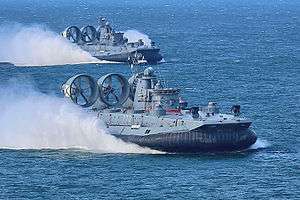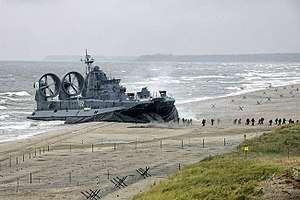Zubr-class LCAC
 Mordoviya and Evgeniy Kocheshkov | |
| Class overview | |
|---|---|
| Builders: | PO More Feodosia Shipbuilding Company, Crimea |
| Operators: | |
| In commission: | 1988–present |
| Planned: | 17 |
| Completed: | 15 |
| Cancelled: | 2 |
| Active: | 10 |
| Retired: | 5 |
| Scrapped: | 5 |
| General characteristics | |
| Type: | Air-cushioned landing craft |
| Displacement: |
|
| Length: | 57 m (187 ft)[2] |
| Beam: | 25.6 m (84 ft)[3] |
| Draught: | 1.6 m (5.2 ft)[2] |
| Propulsion: |
|
| Speed: | |
| Range: | 300 nmi (560 km) at 55 knots |
| Complement: | 31 (4 officers, 27 enlisted)[1] |
| Sensors and processing systems: | Ekran-1 navigational radar, Lazur radar (Pozitiv radar on MDK-51), R-782 Buran communications system |
| Electronic warfare & decoys: | Electronic Countermeasures System: Decoys, MS-227 chaff launcher, MP-411 ESM radar system; intercept |
| Armament: |
|
The Zubr class (Project 1232.2, NATO reporting name "Pomornik") is a class of air-cushioned landing craft (LCAC). This class of military hovercraft is, as of 2012, the world's largest, with a standard full load displacement of 555 tons.[1][4] The hovercraft is designed to sealift amphibious assault units (such as marines and tanks) from equipped/non-equipped vessels to non-equipped shores, as well as transport and plant naval mines.
There are ten Zubr-class hovercraft in service. There are two vessels in the Russian Navy and four with the Hellenic Navy.[3] In 2009, China placed an order for four vessels from Ukraine [order transferred to Russia now] as part of a deal worth 315 million USD.[5] Two updated versions of the vessels were built by Crimea's Feodosia Shipbuilding Company, followed by two advanced models of the surface warship.[5][6]
The purchase of HS Cephalonia (L 180) for the Hellenic Navy marked the first time a Soviet-designed naval craft had been built for a NATO member.[7][8][9][10]
In June 2017, Russia announced it was restarting production of the Zubr-class craft.[11] Representatives from the Russian shipbuilding industry soon after responded by stating production could not possibly resume in 2018 and would only be possible by 2019–2021, refuting the government position. Representatives cited the lack of availability of and inability to mass-produce components, notably gas turbine engines and reduction gears as the main obstacles.[12]
NPO Saturn (ODK GT) and Turboros developed marine gas turbine M70FRU (D090), FR RU, M70FRU2 (DP/DM71) along M90FR, M75RU, E70RD8 and Elektrosila, AO Zvezda, Metallist, Samara and others developed reductors and gears. Fan and Turboprop provided by NK Kuznetsov, Aerosila, among others (perhaps some like Aviadvigatel, Salut, AMNTK, UMPO, KMPO, having high and long experience and production).[13]
Configuration

High strength and buoyancy is provided by a rectangular pontoon, the main load-carrying part of the ship's hull. The superstructure built on the pontoon is divided into three compartments with two longitudinal bulkheads: combat material compartment in the midsection fitted with tank ramps, and outboard sections housing main and auxiliary propulsion units, troop compartments, living quarters, and NBC protection systems. To improve working conditions in the battle stations, troop compartments and living quarters are fitted with air-conditioning and heating-systems, sound/heat-insulating coatings, and structures made of vibration damping materials. The ship provides normal conditions for the crew to make meals and rest.
Personnel are protected against the effects of weapons of mass destruction by airtight sealing of combat stations, crew and troop compartments, augmented with individual gas masks and protection suits. The ship is also protected from magnetic influence mines with an active system to compensate for the magnetic fields generated by the ship and transported materials. The central command post and MS-227 device compartments are strengthened with alloy armor.
Capacity
The Zubr-class landing craft has a cargo area of 400 square metres (4,300 sq ft) and a fuel capacity of 56 tons.[2] It can carry three main battle tanks (up to 150 tonnes), or ten armoured vehicles with 140 troops (up to 131 tonnes), or 8 armoured personnel carriers of total mass up to 115 tonnes, or 8 amphibious tanks or up to 500 troops (with 360 troops in the cargo compartment).
At full displacement the ship is capable of negotiating up to 5-degree gradients on non-equipped shores and 1.6 m (5 ft 3 in)-high vertical walls. The Zubr class remains seaworthy in conditions up to Sea State 4. The vessel has a cruising speed of 30–40 knots (56–74 km/h; 35–46 mph).
Operators
![]()
- 770 Evgeniy Kocheshkov (former MDK-50)
- 782 Mordoviya (former MDK-94)
![]()
- HS Cephalonia (L 180, former MDK-118)
- HS Ithaca (L 181, former U421)
- HS Corfu (L 182)
- HS Zakynthos (L 183)
![]()
Former operators
![]()
- Donetsk (U420, former MDK-100) — decommissioned on 11 June 1999, scrapped
- Kramatorsk (U422, former MDK-57) — decommissioned on 11 June 1999, scrapped
- Horlivka (U423, former MDK-93) — decommissioned on 29 November 2000, scrapped
- Artemivsk (U424, former MDK-123) — sold to Greece on 24 January 2000
See also
Notes
- 1 2 3 4 5 Wertheim, The Naval Institute Guide to Combat Fleets of the World: Their Ships, Aircraft, and Systems, 128
- 1 2 3 Jane's Information Group, Jane's international defence review
- 1 2 "Zubr Class (Pomornik) Air Cushioned Landing Craft, Russia". naval-technology.com. 2011. Retrieved 2011-08-02.
- ↑ Hellenic Navy (2008). "Hellenic Command Amphibious Forces: Ships". Hellenic Navy. Retrieved 2009-04-18.
- 1 2 "Ukraine crisis prompts hurried delivery of second Zubr LCAC to China". IHS Jane's. 6 March 2014. Retrieved 5 January 2015.
- ↑ "China To RePay $14 Million Debt To Crimea For Zubr-class Landing Craft". www.defenseworld.net. Retrieved 2017-12-05.
- ↑ Hellenic Navy (2008). "Hellenic Command Amphibious Forces: Introduction". Hellenic Navy. Retrieved 2009-04-18.
- ↑ Kitov, Vladimir (2000-11-04). "Almaz launches NATO-bound craft". The Russia Journal. Retrieved 2009-04-18.
- ↑ Titova, Irina (2000-12-29). "City Shipyard Hovercraft Is 1st Delivery to NATO State". The St. Petersburg Times. Retrieved 2009-04-18.
- ↑ Jones, Bruce (16 June 2017). "Russia to resume construction of Zubr hovercraft". IHS Jane's 360. Archived from the original on 16 June 2017. Retrieved 16 June 2017.
- ↑ "Production of Zubr-Class Air-Cushion Ships Resumes Only in 2019-2021, Shipbuilders Say". Mil Today. 18 June 2017. Archived from the original on 19 June 2017. Retrieved 19 June 2017.
- ↑ http://www.armstrade.org/includes/periodics/news/2018/0914/095548709/detail.shtml
References
- Saunders, Stephen (RN) (2003). Jane's Fighting Ships 2003-2004. Jane's Information Group. ISBN 978-0-7106-2546-5.
- Jane's Information Group (2002). Jane's international defence review: IDR. Jane's Information Group. Retrieved 2009-04-18.
- Wertheim, Eric (2007). The Naval Institute Guide to Combat Fleets of the World: Their Ships, Aircraft, and Systems (15, illustrated ed.). Naval Institute Press. ISBN 978-1-59114-955-2. Retrieved 2009-04-18.
External links
| Wikimedia Commons has media related to Zubr class LCAC. |
- Vessel description (in Russian) on YouTube
- "Zubr Class (Pomornik) - Naval Technology". naval-technology.com. Retrieved 2014-05-31.
- (in Greek) http://www.hellenicnavy.gr/index.php?option=com_content&view=article&id=57%3Adad-istoriko&catid=74%3Adad&Itemid=226&lang=el
- (in Greek) http://www.hellenicnavy.gr/index.php?option=com_content&view=article&id=325&Itemid=315&lang=el
- (in English) All Zubr class LCAC - Complete Ship List
- "Десантный корабль "Зубр" проект 12322". almaz.spb.ru. Retrieved 2014-05-31.
